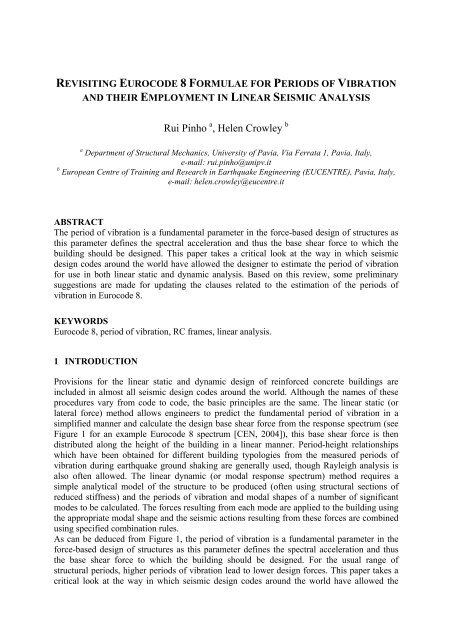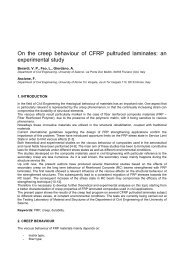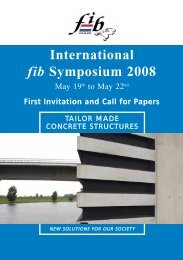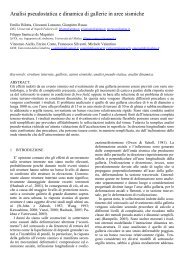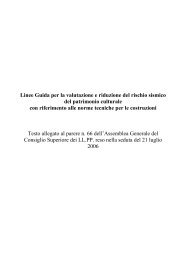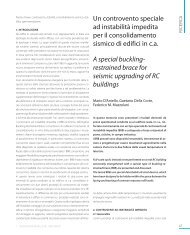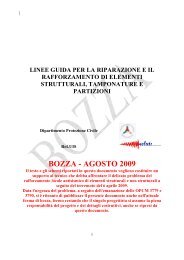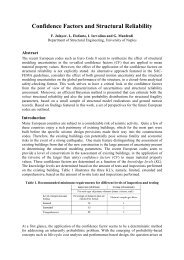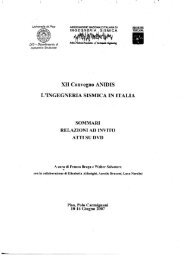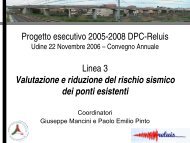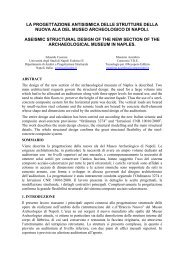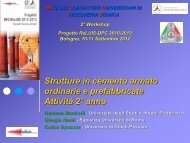Revisiting Eurocode 8 Formulae for Periods of Vibration - ReLUIS
Revisiting Eurocode 8 Formulae for Periods of Vibration - ReLUIS
Revisiting Eurocode 8 Formulae for Periods of Vibration - ReLUIS
You also want an ePaper? Increase the reach of your titles
YUMPU automatically turns print PDFs into web optimized ePapers that Google loves.
REVISITING EUROCODE 8 FORMULAE FOR PERIODS OF VIBRATIONAND THEIR EMPLOYMENT IN LINEAR SEISMIC ANALYSISRui Pinho a , Helen Crowley ba Department <strong>of</strong> Structural Mechanics, University <strong>of</strong> Pavia, Via Ferrata 1, Pavia, Italy,e-mail: rui.pinho@unipv.itb European Centre <strong>of</strong> Training and Research in Earthquake Engineering (EUCENTRE), Pavia, Italy,e-mail: helen.crowley@eucentre.itABSTRACTThe period <strong>of</strong> vibration is a fundamental parameter in the <strong>for</strong>ce-based design <strong>of</strong> structures asthis parameter defines the spectral acceleration and thus the base shear <strong>for</strong>ce to which thebuilding should be designed. This paper takes a critical look at the way in which seismicdesign codes around the world have allowed the designer to estimate the period <strong>of</strong> vibration<strong>for</strong> use in both linear static and dynamic analysis. Based on this review, some preliminarysuggestions are made <strong>for</strong> updating the clauses related to the estimation <strong>of</strong> the periods <strong>of</strong>vibration in <strong>Eurocode</strong> 8.KEYWORDS<strong>Eurocode</strong> 8, period <strong>of</strong> vibration, RC frames, linear analysis.1 INTRODUCTIONProvisions <strong>for</strong> the linear static and dynamic design <strong>of</strong> rein<strong>for</strong>ced concrete buildings areincluded in almost all seismic design codes around the world. Although the names <strong>of</strong> theseprocedures vary from code to code, the basic principles are the same. The linear static (orlateral <strong>for</strong>ce) method allows engineers to predict the fundamental period <strong>of</strong> vibration in asimplified manner and calculate the design base shear <strong>for</strong>ce from the response spectrum (seeFigure 1 <strong>for</strong> an example <strong>Eurocode</strong> 8 spectrum [CEN, 2004]), this base shear <strong>for</strong>ce is thendistributed along the height <strong>of</strong> the building in a linear manner. Period-height relationshipswhich have been obtained <strong>for</strong> different building typologies from the measured periods <strong>of</strong>vibration during earthquake ground shaking are generally used, though Rayleigh analysis isalso <strong>of</strong>ten allowed. The linear dynamic (or modal response spectrum) method requires asimple analytical model <strong>of</strong> the structure to be produced (<strong>of</strong>ten using structural sections <strong>of</strong>reduced stiffness) and the periods <strong>of</strong> vibration and modal shapes <strong>of</strong> a number <strong>of</strong> significantmodes to be calculated. The <strong>for</strong>ces resulting from each mode are applied to the building usingthe appropriate modal shape and the seismic actions resulting from these <strong>for</strong>ces are combinedusing specified combination rules.As can be deduced from Figure 1, the period <strong>of</strong> vibration is a fundamental parameter in the<strong>for</strong>ce-based design <strong>of</strong> structures as this parameter defines the spectral acceleration and thusthe base shear <strong>for</strong>ce to which the building should be designed. For the usual range <strong>of</strong>structural periods, higher periods <strong>of</strong> vibration lead to lower design <strong>for</strong>ces. This paper takes acritical look at the way in which seismic design codes around the world have allowed the
2R. Pinho, H. Crowleydesigner to estimate the period <strong>of</strong> vibration <strong>for</strong> use in both linear static and dynamic analysis.The influence <strong>of</strong> the period <strong>of</strong> vibration on the design will be briefly discussed and somepreliminary proposals <strong>for</strong> updating the periods <strong>of</strong> vibration in linear analysis in <strong>Eurocode</strong> 8will be made.0.35Spectra l Acceleration (g)0.300.250.200.150.100.05T c∝ 1/T∝ 1/T 20.000.0 0.5 1.0 1.5 2.0 2.5 3.0 3.5 4.0Period (sec)Figure 1. Type 1 acceleration response spectrum in <strong>Eurocode</strong> 8 <strong>for</strong> a peak ground acceleration <strong>of</strong> 0.1g andsite condition C [CEN, 2004].2 PERIOD OF VIBRATION IN DESIGN CODES2.1 Period-height relationships in seismic design codes <strong>for</strong> moment resisting framesThe fundamental period <strong>of</strong> vibration required <strong>for</strong> the simplified design <strong>of</strong> rein<strong>for</strong>ced concretestructures has been calculated <strong>for</strong> many years using a simplified <strong>for</strong>mula relating the period tothe height <strong>of</strong> the building. One <strong>of</strong> the first <strong>for</strong>mulae <strong>of</strong> this type was presented almost 30 yearsago in ATC3-06 [ATC, 1978] and had the <strong>for</strong>m:3/ 4T = C H(1)twhere C t was a regression coefficient and H represented the height <strong>of</strong> the building in feet.As discussed in Goel and Chopra [1997], the particular <strong>for</strong>m <strong>of</strong> Eq. (1) was theoreticallyderived by assuming that the equivalent static lateral <strong>for</strong>ces are linearly distributed over theheight <strong>of</strong> the building and the distribution <strong>of</strong> stiffness with height produces a uni<strong>for</strong>m storeydrift under the linearly distributed lateral <strong>for</strong>ces. Furthermore in ATC3-06 [ATC, 1978] thebase shear <strong>for</strong>ce was assumed to be inversely proportional to T 2/3 and thus these twoassumptions led to Eq. (1), as shown in the workings below.The period <strong>of</strong> vibration (T) <strong>of</strong> a single degree <strong>of</strong> freedom oscillator can be obtained from Eq.(2) where m is the mass <strong>of</strong> the oscillator and k is the stiffness:mT = 2 π(2)kThe stiffness <strong>of</strong> the oscillator can be obtained from the base shear (V) divided by the lateraldisplacement (∆). From the response spectrum in early design codes, the base shear <strong>for</strong> the
<strong>Revisiting</strong> <strong>Eurocode</strong> 8 <strong>Formulae</strong> <strong>for</strong> <strong>Periods</strong> <strong>of</strong> <strong>Vibration</strong> and their Employment in Linear Seismic Analysis 3usual range <strong>of</strong> periods <strong>of</strong> structures was taken as inversely proportional to the period to thepower <strong>of</strong> two-thirds, with the coefficient <strong>of</strong> proportionality defined as C 1 herein. Asmentioned previously, if one assumes that the distribution <strong>of</strong> stiffness with height produces auni<strong>for</strong>m storey drift under the linearly distributed lateral <strong>for</strong>ces, then the lateral displacement,∆ is given by the interstorey drift, ϑ, multiplied by the height, H:V C1 C1= =(3)2 / 3 2∆ T ∆ T ϑHk =/ 3By replacing Eq. (3) in Eq. (2), the relationship shown in Eq. (1) between period and heightcan be obtained, as outlined in the workings <strong>of</strong> Eq. (4) to (6):2 / 3mT HϑT = 2π(4)C12T2 / 32 mT Hϑ(2π)C1= (5)T4 / 3= C Ht(6)In ATC3-06 [ATC, 1978], the coefficient C t in Eq. (1) was given equal to 0.025 <strong>for</strong> rein<strong>for</strong>cedconcrete moment resisting frames. This coefficient was identified from a study by Gates andFoth [1978] based on the measured periods <strong>of</strong> vibration <strong>of</strong> rein<strong>for</strong>ced concrete frames duringthe 1971 San Fernando earthquake. A subsequent re-evaluation by SEAOC-88 [SEAOC,1988] found that a value <strong>of</strong> Ct=0.03 was more appropriate <strong>for</strong> rein<strong>for</strong>ced concrete buildings.The coefficient Ct was generally calibrated such that the derived fundamental period wouldunderestimate the period by approximately 10-20% at first yield to obtain a conservativeestimate <strong>for</strong> the base shear [Goel and Chopra, 1997].Bertero et al. [1988] studied in greater detail the fourteen buildings considered by Gates andFoth [1978] and found that four <strong>of</strong> the buildings and the longitudinal direction <strong>of</strong> a fifthbuilding could not be considered as moment-resisting frame (MRF) structures and they thusexcluded them from the database. They further identified two buildings with structuraldamage and two others that had non-structural damage; they discuss how damage leads tostiffness degradation and thus an increase in the period <strong>of</strong> vibration. Gates and Foth [1978]did not relate the building damage to the period <strong>of</strong> vibration and thus Bertero et al. [1988] reevaluatedthe time histories <strong>of</strong> building response <strong>for</strong> the moment-resisting frame structuresand identified times where a sudden increase in the period <strong>of</strong> vibration took place, which wasthen correlated to the onset <strong>of</strong> non-structural and structural damage. The period <strong>of</strong> vibration atthe second increase in period was considered to be the stage when the non-structuralcomponents were no longer contributing significantly to the stiffness and interpreted as theperiod at which the building was essentially vibrating as a bare structural frame. They addeda further four buildings to the database and evaluated the bare frame period <strong>of</strong> vibration <strong>for</strong> allbuildings in a uni<strong>for</strong>m manner at the a<strong>for</strong>ementioned second increase in period. Theconclusions <strong>of</strong> their study was that the <strong>for</strong>mula <strong>of</strong> Eq. (1) with C t equal to 0.03 does notconstitute a reliable estimate <strong>of</strong> the during earthquake period <strong>of</strong> rein<strong>for</strong>ced concrete momentresistingframes, and a better fit was found with C t =0.04 (0.097 with H in metres). For alower bound estimate <strong>of</strong> the period, Bertero et al. [1988] recommend the use <strong>of</strong> C t = 0.035(0.085 with H in metres).
4R. Pinho, H. CrowleyIn the buildings used in the Bertero et al. [1988] study, the partition walls were generallyplaster board/dry walls whilst the outer infill was <strong>of</strong>ten constructed with glass curtain wallswith spandrels built into the outer frames. Bendimerad et al. [1991] found that theparticipation <strong>of</strong> these non-structural components on the stiffness <strong>of</strong> the building was minimalcompared to the stiffness <strong>of</strong> the frame and thus had practically no effect on the buildingperiod beyond the first 5 seconds <strong>of</strong> earthquake motion. Hence, the use <strong>of</strong> the equationderived from these buildings <strong>for</strong> the design <strong>of</strong> “moment resisting frame systems <strong>of</strong> rein<strong>for</strong>cedconcrete in which the frames resist 100 percent <strong>of</strong> the required seismic <strong>for</strong>ce” appears to bejustified.The use <strong>of</strong> the <strong>for</strong>m <strong>of</strong> period-height equation shown in Eq. (1), along with the SEAOC-88recommended 0.03 coefficient, has been adopted in many design codes since 1978, <strong>for</strong>example in UBC-97 [UBC, 1997], in SEAOC-96 [SEAOC, 1996], in NEHRP-94 [FEMA,1994] and in <strong>Eurocode</strong> 8 [CEN 1994; 2004]. In <strong>Eurocode</strong> 8, the C t coefficient has simply beentrans<strong>for</strong>med considering that the height is measured in metres, leading to C t = 0.075. In asimilar way that the use <strong>of</strong> a 475 year return period to define the seismic actions was adoptedin seismic design codes around the world [see e.g. Bommer and Pinho, 2006], the periodheightequation <strong>of</strong> Eq. (1) with C t =0.075 has also spread around the world (see <strong>for</strong> examplethe design codes <strong>of</strong> the following countries: Algeria ‘88; Cuba ‘94; El Salvador ‘89; Israel‘95; Korea ‘88; Panama ‘94; Philippines ‘92) [IAEE, 1996; 2000].Goel and Chopra [1997] used the fundamental period <strong>of</strong> vibration <strong>of</strong> buildings measured fromtheir motions recorded during eight Cali<strong>for</strong>nia earthquakes from 1971 to 1994 to update theperiod-height <strong>for</strong>mula in UBC-97. They found that the best fit lower bound curve (i.e. themean –1 standard deviation) <strong>for</strong> rein<strong>for</strong>ced concrete frames was given by:0.90.0466HT = (H in metres) (7)This period-height <strong>for</strong>mula has recently been included in ASCE 7-05 [2006]. As can be notedfrom Eq. (7), Goel and Chopra [1997] decided to move away from the 0.75 power regressionand found the best-fit regression to be 0.9. Simplified period-height equations can only beapplied in <strong>Eurocode</strong> 8 <strong>for</strong> buildings up to 40 metres, and thus the period <strong>of</strong> vibration obtainedwith such equations will generally be within the range <strong>of</strong> inverse proportionality between baseshear and period (see Figure 1). By repeating the calculations in Eq. (2) to (6) with the baseshear <strong>for</strong>ce inversely proportional to T (i.e. V=C 1 /T), the <strong>for</strong>m <strong>of</strong> the period-height equationbecomes linear:T= C H(8)tThe reason that Goel and Chopra [1997] did not arrive at a linear relationship between periodand height is probably because they did not just focus on the buildings whose base shearshould be inversely proportional to period, but included taller buildings in the range <strong>of</strong> “nonproportionality”.Based on the fact that an updated period-height equation <strong>for</strong> RC frames hasnow been proposed, as well as the possibility that a linear equation might be more valid <strong>for</strong>frames designed to <strong>Eurocode</strong> 8, an examination <strong>of</strong> the periods <strong>of</strong> vibration <strong>of</strong> newly designedEuropean rein<strong>for</strong>ced concrete bare frames is thus warranted; this issue is considered further inSection 2.3.
<strong>Revisiting</strong> <strong>Eurocode</strong> 8 <strong>Formulae</strong> <strong>for</strong> <strong>Periods</strong> <strong>of</strong> <strong>Vibration</strong> and their Employment in Linear Seismic Analysis 52.2 Period-height relationships in seismic design codes <strong>for</strong> structures with rein<strong>for</strong>cedconcrete or masonry wallsThe first period-height relationship <strong>for</strong> buildings with concrete shear walls had the <strong>for</strong>mpresented in Eq. (9) and, as with the previous equations, was also calibrated using themeasured motions <strong>of</strong> buildings recorded during the 1971 San Fernando earthquake:TCtH= (9)Dwhere D is the dimension <strong>of</strong> the building at its base in the direction under consideration. Withthe height and dimension D <strong>of</strong> the building measured in feet, C t was proposed in ATC3-06[ATC, 1978] as 0.05 (which would be 0.09 with these dimensions measured in metres). This<strong>for</strong>mula comes from the equation <strong>of</strong> the frequency <strong>of</strong> vibration <strong>of</strong> a cantilever (consideringshear de<strong>for</strong>mations only), with the thickness <strong>of</strong> the wall considered to be more or less constantand thus only the width/length <strong>of</strong> the building is an input parameter, as demonstrated in Eq.(10):Tm H αHαHα1H= 4 = = =(10)κGA A Dt Dwwhere m is the mass per unit length, G is the shear modulus, κ is the shape factor to account<strong>for</strong> non uni<strong>for</strong>m distribution <strong>of</strong> shear stresses, D is the length <strong>of</strong> the cantilever and t w is thethickness. This <strong>for</strong>mula is used in many design codes around the world, but the type <strong>of</strong>structure to which it is applied varies from code to code, as illustrated in Table 1; it is notedthat the text used in each code to describe the structures to which Eq. (9) applies has beenmaintained. Some codes use this <strong>for</strong>mula specifically <strong>for</strong> buildings with both frames and shearwalls, some use the equation <strong>for</strong> rein<strong>for</strong>ced concrete MRF with masonry infill panels, butmany specify it <strong>for</strong> use with any building except moment resisting space frames.Table 1. Buildings to which Eq. (9) is applied in different codes from around the World [IAEE, 1996;2000].Country, Year Type <strong>of</strong> Structure to which Eq. (9) is appliedAlbania, 1989 RC framed structures with brick masonry infill walls participating inseismic <strong>for</strong>ce resistanceAlgeria,1988 Steel or RC moment resisting frames with infilled masonry and partial ortotal RC shear walls, braced frames, and masonry wallsCanada, 1995 Other structures (i.e. not moment resisting frames)Colombia 1984 Other structures (i.e. all except framed structures where the frame is notbraced by rigid elements that tend to impede the free deflection)Cuba, 1995 RC buildings with frames and shear wallsEgypt, 1988 All buildings except moment resisting space framesEl Salvador, All buildings except frames1989Ethiopia, 1983India, 1984All buildings except those with moment resisting space frames capable <strong>of</strong>resisting 100% <strong>of</strong> the required lateral <strong>for</strong>ced and not enclosed by oradjoined by more rigid elementsOther structures (not moment resisting frames without bracing or shearwalls <strong>for</strong> resisting lateral loads)
6R. Pinho, H. CrowleyCountry, YearIran, 1988Israel, 1975Italy, 1986 &1996Peru, 1977Venezuela, 1982Type <strong>of</strong> Structure to which Eq. (9) is appliedAll buildings except moment resisting frames, if other elements do notcreate an obstacle to the movement <strong>of</strong> the building frameMulti-storey structures in which horizontal <strong>for</strong>ces are carried by RCframesFor framed structures (N.B. C t from Eq. (9) is taken as equal to 0.1)For buildings whose structural elements are exclusively open frames andshear walls <strong>of</strong> the elevator, without other elements <strong>for</strong> providing rigidityto the structureStructures consisting <strong>of</strong> frames and structural walls <strong>of</strong> rein<strong>for</strong>ced concreteor braced framesThe UBC-97 code [UBC, 1997] did not use Eq. (9) <strong>for</strong> shear wall buildings, but insteadreported empirical equations <strong>of</strong> the <strong>for</strong>m <strong>of</strong> Eq. (1), where C t was taken equal to 0.02 with theheight measured in feet and 0.05 with the height measured in metres. This <strong>for</strong>mula hasbecome the “other structures” <strong>for</strong>mula in <strong>Eurocode</strong> 8 [CEN, 2004] and is also present in theAlgeria 1988 code as another possible <strong>for</strong>mula to be used <strong>for</strong> steel or RC moment resistingframes with infilled masonry and partial or total RC shear walls, braced frames, and masonrywalls. The Algerian code is much more explicit about the coefficient to be used in Eq. (1) <strong>for</strong>RC buildings with and without infilled frames; it is believed by the authors that manydesigners following <strong>Eurocode</strong> 8 would use Eq. (1) with C t equal to 0.075 <strong>for</strong> all rein<strong>for</strong>cedconcrete buildings regardless <strong>of</strong> the details <strong>of</strong> the masonry infills. Hence, considering thatmany rein<strong>for</strong>ced concrete buildings in Europe are constructed with stiff masonry infill panelswhich are <strong>of</strong>ten not isolated from the RC frame, the period <strong>of</strong> vibration is probably beingoverestimated by the designers and thus the <strong>for</strong>ces are subsequently being underestimated.This issue is considered further in Section 3.Another value <strong>of</strong> C t to be used in Eq. (1) was permitted <strong>for</strong> buildings with shear walls in theUBC-97 and SEAOC-96 [SEAOC, 1996] documents, based on the following <strong>for</strong>mula:Ct0.1= (11)Acwhere A c , the combined effective area (in square feet) <strong>of</strong> the shear walls is defined as:NW2⎡ ⎛ D ⎤i ⎞Ac = ∑ Ai⎢0.2+ ⎜ ⎟ ⎥ ; D i / H ≤ 0. 9(12)i=1 ⎢⎣⎝ H ⎠ ⎥⎦in which A i is the horizontal cross-sectional area (in square feet); D i is the dimension in thedirection under consideration (in feet) <strong>of</strong> the i th shear wall in the first storey <strong>of</strong> the structure;and NW is the number <strong>of</strong> shear walls. The numerator <strong>of</strong> Eq. (11) becomes 0.075 when thedimensions <strong>of</strong> the structure are measured in metres. This equation has also found its way in<strong>Eurocode</strong> 8 [CEN, 2004] as the <strong>for</strong>mula to be used <strong>for</strong> structures with concrete or masonryshear walls; however, the <strong>for</strong>mula <strong>for</strong> A c , given below in Eq. (13), appears to be slightlydifferent to the original <strong>for</strong>mula in Eq. (12) which the authors believe might be due to anediting error.
<strong>Revisiting</strong> <strong>Eurocode</strong> 8 <strong>Formulae</strong> <strong>for</strong> <strong>Periods</strong> <strong>of</strong> <strong>Vibration</strong> and their Employment in Linear Seismic Analysis 7NW2⎡⎛⎛ D ⎤i ⎞⎞Ac = ∑ Ai⎢⎜0.2+ ⎜ ⎟⎟⎥(13)i=1 ⎢⎣⎝ ⎝ H ⎠⎠⎥⎦Goel and Chopra [1998] and Lee et al. [2000] both show how Eq. (9) and (11) are tooconservative <strong>for</strong> shear wall buildings when compared with the measured periods <strong>of</strong> vibration<strong>of</strong> buildings during earthquakes. Goel and Chopra [1998] discuss how there is littlecorrelation between thebecause the shear walls do not extend <strong>for</strong> the whole dimension “D” <strong>of</strong> the buildings, but <strong>for</strong>just a small proportion. On the other hand, Eq. (11) which includes explicitly the dimensions<strong>of</strong> the walls, appears to be better correlated to the period <strong>of</strong> vibration, but was neverthelessfound to be too conservative. Both Goel and Chopra [1998] and Lee et al. [2000] decided tocalibrate an equation <strong>for</strong> the period <strong>of</strong> vibration <strong>of</strong> shear wall structures by considering thefundamental period <strong>of</strong> a uni<strong>for</strong>m cantilever beam with both flexural and shear de<strong>for</strong>mations.Figure 2 shows the period <strong>of</strong> vibration <strong>of</strong> a cantilever with both flexural and shearde<strong>for</strong>mations (based on Dunkerley’s method – see Inman [1996]) divided by the period <strong>of</strong>vibration <strong>of</strong> a pure-flexural cantilever as a function <strong>of</strong> the ratio <strong>of</strong> height to depth (H/D). Thisplot shows that the period approaches the period <strong>of</strong> a pure-shear cantilever as the height todepth ratio becomes smaller, and the period <strong>of</strong> a pure-flexure cantilever as the ratio increases.For shear walls with H/D ratios between 0.2 and 5, the contribution <strong>of</strong> both flexure and shearto the period <strong>of</strong> vibration should be considered.H / D value <strong>of</strong> Eq. (9) and the period <strong>of</strong> vibration. This could beFigure 2. Fundamental period <strong>of</strong> cantilever beams as a function <strong>of</strong> height to depth ratio [Goel andChopra, 2008]Goel and Chopra [1998] calibrated Dunkerley’s equation using the measured periods <strong>of</strong>vibration <strong>of</strong> shear wall buildings and obtained the <strong>for</strong>mula which is shown in Eq. 14; thisequation has recently been included in ASCE 7-05 [2006].0.0019T = HCw
8R. Pinho, H. CrowleywhereCw100=ABNW∑i=1A⎡ ⎛ hi⎞⎢1+ 0.83⎢⎜⎟⎣ ⎝ Di⎠i2⎤⎥⎥⎦(14)2.3 <strong>Periods</strong> <strong>of</strong> vibration <strong>of</strong> case study buildingsThe period-height relationships derived in the past, and described in the previous sections,have been obtained from the measured period <strong>of</strong> vibration <strong>of</strong> buildings built over a longperiod <strong>of</strong> time to different design codes; this variation in the age <strong>of</strong> the buildings, and thusdesign regulations, might be part <strong>of</strong> the reason <strong>for</strong> the large scatter in the results. Buildingsdesigned to more recent seismic design codes with higher lateral <strong>for</strong>ce requirements andcapacity design principles are more likely to have larger columns and are thus likely to bestiffer. A number <strong>of</strong> European moment resisting rein<strong>for</strong>ced concrete frames were modelled byCrowley [2003] using SeismoStruct [SeismoS<strong>of</strong>t, 2008], a fibre-element finite elementsstructural analysis package, and Eigenvalue analysis was carried out to compute theirfundamental periods <strong>of</strong> vibration. The results showed that there was a large difference in thestiffness <strong>of</strong> the buildings designed pre- and post-1980 (Figure 2), most likely due to thechanges in design philosophy mentioned previously. The <strong>Eurocode</strong> 8 equation [CEN, 2004]which was obtained by converting Eq. (1) from feet to metres appears to match well theperiod <strong>of</strong> vibration <strong>of</strong> these newer European buildings, though as mentioned in Section 1 therehave been a number <strong>of</strong> criticisms <strong>of</strong> the post-processing <strong>of</strong> the data which led to this equationand it was found to be too conservative. However, considering that more recent Europeanbuildings are stiffer than older pre-1980 buildings, the equation now appears to be morereliable. The recently proposed upper and lower bound equations by Goel and Chopra [1997]which were obtained from a number <strong>of</strong> buildings subjected to earthquakes in Cali<strong>for</strong>nia from1971 to 1994 are also shown in Figure 2. The characteristics <strong>of</strong> the buildings in Cali<strong>for</strong>niamay not have changed so extensively during the last 40 years as they appear to have done inEurope, and so the scatter in the Goel and Chopra data may not be due to age, but it would bean interesting study to see if the scatter could be reduced by including this parameter.21.81.61.4Goel & Chopra (1997) Lower BoundGoel & Chopra (1997) Upper BoundPost-1980 FramesPre-1980 Frames<strong>Eurocode</strong> 8 Equation MRFPeriod (s)1.210.80.60.40.200 10 20 30 40Height (m)Figure 3. Upper and lower bound period-height <strong>for</strong>mulae by Goel and Chopra [1997] and the EC8 [CEN,2004] <strong>for</strong> bare MRF compared with the gross stiffness periods <strong>of</strong> vibration from European bare MRFdesigned pre- and post-1980 [see Crowley and Pinho, 2004; Crowley, 2003]
<strong>Revisiting</strong> <strong>Eurocode</strong> 8 <strong>Formulae</strong> <strong>for</strong> <strong>Periods</strong> <strong>of</strong> <strong>Vibration</strong> and their Employment in Linear Seismic Analysis 9In Europe, it is very common to add rigid masonry infill panels to rein<strong>for</strong>ced concretemoment resisting frames, both internally and externally; these non-structural elements willinfluence both the lateral stiffness and strength <strong>of</strong> the building. <strong>Eurocode</strong> 8 allows thedesigner to ignore the contribution <strong>of</strong> the infill panels to the strength <strong>of</strong> the building (byconsidering them as non-structural elements), and the authors believe that many designersfollowing the recent <strong>Eurocode</strong> 8 regulations would also ignore their contribution to thestiffness. <strong>Eurocode</strong> 8 states in the modelling section that “infill walls which contributesignificantly to the lateral stiffness and resistance <strong>of</strong> the building should be taken intoaccount” but there is no guidance on how they should be modelled. If the designers use thelinear static method to design the building then they may mistakenly use a moment resistingspace frame equation to calculate the period <strong>of</strong> vibration, or otherwise use the Rayleighmethod, where the de<strong>for</strong>med shape is obtained from a numerical model where the infill panelsare not included. For what concerns the linear dynamic method, where Eigenvalue analyis isrequired to calculate the periods <strong>of</strong> a number <strong>of</strong> modes <strong>of</strong> vibration, again it is probable thatthese rigid elements are not being included in the numerical model.In order to consider the influence <strong>of</strong> this type <strong>of</strong> rigid masonry infill on the period <strong>of</strong> vibration<strong>of</strong> rein<strong>for</strong>ced concrete moment resisting frames, Angel [2007] added equivalent struts to thepost-1980 European frame models mentioned previously; the thickness <strong>of</strong> the infill was takenas either 100mm or 250mm and the panels were modelled as either fully infilled, or with anumber <strong>of</strong> openings. The periods <strong>of</strong> vibration <strong>of</strong> these four types <strong>of</strong> infilled frames are shownin Figure 3, together with the period <strong>of</strong> vibration <strong>of</strong> the bare frames.Period (s)1.61.41.210.80.6Bare frame100mm Fully infilled250mm Fully infilled100mm Openings250mm Openings0.40.200 5 10 15 20 25 30 35 40Height (m)Figure 4. <strong>Periods</strong> <strong>of</strong> vibration <strong>of</strong> post-1980 rein<strong>for</strong>ced concrete moment resisting frames modelling withinfill panels with varying characteristicsThe distribution <strong>of</strong> the infill panels will vary within a building with some frames fully infilled,some with openings, whilst some frames will remain bare. Bal et al. [2008] studied thecharacteristics <strong>of</strong> Turkish rein<strong>for</strong>ced concrete buildings and found that the proportion <strong>of</strong> bareframes, fully infilled frames and partially infilled frames in a sample <strong>of</strong> Turkish buildings tobe 34%, 28% and 38%, respectively. These ratios have been used to calculate a weightedmean period <strong>of</strong> vibration <strong>for</strong> each frame presented in Figure 3, considering 50% with 100mminfills and 50% with 250mm infills. The period <strong>of</strong> vibration <strong>of</strong> the same frames has also beencalculated using Eq. (9) and with the <strong>for</strong>mula <strong>for</strong> “other structures” in <strong>Eurocode</strong> 8 (Eq. (1)
10R. Pinho, H. Crowleywith C t equal to 0.05); a comparison <strong>of</strong> these code equations with the analytically calculatedperiods <strong>of</strong> vibration is given in Figure 4.The results in Figure 4 show that the periods <strong>of</strong> vibration <strong>for</strong> these infilled post-1980European buildings from numerical analysis match well both Eq. (9) and Eq. (1) (with the C tcoefficient suggested in <strong>Eurocode</strong> 8 <strong>for</strong> “other” structures). The reason that these infilledbuildings agree with these equations, whereas other authors have found that they are tooconservative <strong>for</strong> shear wall structures, is probably due to the low height to width ratios whicharise when you have infill walls in all bays <strong>of</strong> the structure. A low height to width ratioimplies a higher shear de<strong>for</strong>mation contribution to the period <strong>of</strong> vibration and so this may bethe reason why Eq. (9) works well.10.90.80.7Post-1980 Infilled BuildingsT=0.09H/ D^0.5EC8 "Other Structures" FormulaPeriod (s)0.60.50.40.30.20.100 5 10 15 20 25 30 35 40Height (m)Figure 5. <strong>Periods</strong> <strong>of</strong> vibration <strong>of</strong> post-1980 “infilled buildings” based on a weighted mean <strong>of</strong> the results inFigure 2, compared with the periods predicted with Eq. (9) and the <strong>for</strong>mula in Eq. (1) with C t equal to0.053 PERIODS USED IN LINEAR STATIC AND DYNAMIC ANALYSES IN EC8<strong>Eurocode</strong> 8 [CEN, 2004], as with most design codes, allows linear analyses to be carried out<strong>for</strong> the design <strong>of</strong> new structures. Linear analysis includes the lateral <strong>for</strong>ce method (static) andthe modal response spectrum (dynamic) method: both types <strong>of</strong> analysis use smooth responsespectra specified in the code in order to characterise the earthquake actions (see Figure 1).The modal response spectrum analysis is applicable <strong>for</strong> all types <strong>of</strong> buildings, whilst thelateral <strong>for</strong>ce method <strong>of</strong> analysis has many restrictions on its use due to the ‘fear’ that it wouldprovide unconservative results in certain conditions; however, in spite <strong>of</strong> this disadvantage themethod is still widely used due to its ease <strong>of</strong> application.Essentially, the lateral <strong>for</strong>ce method <strong>of</strong> analysis may be applied to buildings whose responseis not extensively affected by the contribution <strong>of</strong> higher modes <strong>of</strong> vibration. According to<strong>Eurocode</strong> 8, such buildings follow two conditions: firstly, the fundamental period <strong>of</strong> freevibration in the principal directions is smaller than either four times the corner period (4T c ,where T c varies from 0.25s to 0.8s) or two seconds; and secondly, the building is regular inelevation. The lateral <strong>for</strong>ce method allows the use <strong>of</strong> the simplified relationships described inSection 2 <strong>for</strong> the estimation <strong>of</strong> the period <strong>of</strong> vibration <strong>of</strong> the building under design. For thosebuildings <strong>for</strong> which the lateral <strong>for</strong>ce method cannot be applied, in many cases it is possible toapply the modal response spectrum method. In order to calculate the periods <strong>of</strong> a number <strong>of</strong>
<strong>Revisiting</strong> <strong>Eurocode</strong> 8 <strong>Formulae</strong> <strong>for</strong> <strong>Periods</strong> <strong>of</strong> <strong>Vibration</strong> and their Employment in Linear Seismic Analysis 11modes <strong>of</strong> vibration, the designer would generally produce a numerical model <strong>of</strong> the buildingand carry out Eigenvalue analysis.Recent studies [Angel et al., 2006; Pinho et al., 2007] have shown through a number <strong>of</strong>examples how the application <strong>of</strong> these two methods to a given building leads to differentdesign base shear <strong>for</strong>ces and shear <strong>for</strong>ce pr<strong>of</strong>iles. Examples <strong>of</strong> the shear <strong>for</strong>ce pr<strong>of</strong>ilesobtained with the two methods <strong>for</strong> two post-1980 European frames are given in Figure 5.4Linear Dynamic AnalysisLinear Static Analysis3Storey2100 10 20 30 40 50 60 70 80 90 100 110 120Shear Force (kN)87Li near Dynami c Analysi sLinear Static Analysis65Storey432100 50 100 150 200 250Shear Force (kN)Figure 6. Shear <strong>for</strong>ce pr<strong>of</strong>iles <strong>for</strong> two rein<strong>for</strong>ced concrete buildings designed to <strong>Eurocode</strong> 8 obtained withthe linear dynamic and static procedures (Pinho et al., 2007)The main reason <strong>for</strong> the differences in the base shear <strong>for</strong>ce in the plots is Figure 5 is thedisparity between the fundamental period <strong>of</strong> vibration from the period-height equation and theperiod <strong>of</strong> vibration from Eigenvalue or Rayleigh analysis <strong>of</strong> a bare frame model, where thestiffness <strong>of</strong> the sections may be reduced by up to 50% [CEN, 2004]. Many codes recognisethat the period <strong>of</strong> vibration from the simplified period-height equation is more realistic,having been directly obtained from the measured periods <strong>of</strong> vibration <strong>of</strong> buildings subject toearthquake ground motions, but that when higher modes are important (in tall and/or irregularstructures) the modal response spectrum method gives a more realistic pr<strong>of</strong>ile <strong>of</strong> the lateral<strong>for</strong>ces. Hence, these codes (e.g. ASCE [2006]; NBCC [2005]) require the designer to checkwhether the modal base shear <strong>for</strong>ce is less than 85% <strong>of</strong> the base shear <strong>for</strong>ce from theequivalent lateral <strong>for</strong>ce method. If this is the case then the modal <strong>for</strong>ces, but not the drifts,should be multiplied by 0.85V/V t where V is the base shear from the lateral <strong>for</strong>ce method andV t is the base shear from the required modal combination.Even when higher modes are not important and the designers are allowed to use the linearstatic method, but they decide to calculate the period <strong>of</strong> vibration from the Rayleigh method,
12R. Pinho, H. Crowleymany codes apply an upper bound to the period <strong>of</strong> vibration from the Rayleigh method. Thisis another procedure which is used to safeguard against unrealistically high periods <strong>of</strong>vibration used in the design to lower the base shear <strong>for</strong>ces. In ASCE 7 (ASCE, 2006) theperiod <strong>of</strong> vibration <strong>of</strong> the building calculated by the designer (perhaps with a numerical modelwith members <strong>of</strong> reduced stiffness) should not be higher than C u multiplied by the periodfrom the standard period-height equations such as those presented in Section 1. Thiscoefficient C u varies from 1.4 to 1.7 as a function <strong>of</strong> the design spectral response accelerationat 1 second; the higher the spectral acceleration the lower the coefficient C u . The empiricalequations have been derived using buildings in areas with higher lateral <strong>for</strong>ce requirementsand the a<strong>for</strong>ementioned variation <strong>of</strong> the coefficient C u is intended to reflect the likelihood thatbuildings in areas with lower lateral <strong>for</strong>ce requirements will be more flexible and hence it isnot necessary to be so stringent on the period to be used <strong>for</strong> design. Furthermore, it results inless dramatic changes from present practice in lower risk areas [FEMA, 2003].<strong>Eurocode</strong> 8 [CEN, 2004] does not include either <strong>of</strong> these clauses, which the authors believeprovide a rational method to avoid unrealistically low seismic design <strong>for</strong>ces, whilst at thesame time allowing the drifts and the higher mode effects to be realistically modelled.4 RECOMMENDATIONS FOR FUTURE DRAFTS OF EUROCODE 8The main recommendation <strong>of</strong> this paper is that future revisions <strong>of</strong> <strong>Eurocode</strong> 8 [CEN, 2004]should consider the following points related to the periods <strong>of</strong> vibration and <strong>for</strong>ces obtained inlinear analysis:• When presenting the period-height equations <strong>for</strong> rein<strong>for</strong>ced concrete momentresisting frames (MRF) there should be two <strong>for</strong>mulae which depend on whether (a)the infill panels are to be isolated from the MRF or (b) the infill panels are to berigidly connected to the MRF.• The period-height equation <strong>for</strong> bare MRF that is currently in <strong>Eurocode</strong> 8 appears tobe reasonable and should not necessarily be updated with the Goel and Chopra[1997] equation, especially considering that this equation is based on buildingsconstructed over many years and thus to different design codes.• The period-height equation <strong>for</strong> “other structures” that is currently included in EC8[CEN, 2004] could be used <strong>for</strong> the period <strong>of</strong> vibration <strong>of</strong> the MRF will rigid infillpanels, as could Eq. (9) with C t =0.09.• The error which the authors appear to have found in the period <strong>of</strong> vibrationequation <strong>for</strong> shear wall buildings should be rectified and this equation could beupdated using the more recent equation proposed by Goel and Chopra [1998].However, it would be interesting to compare this equation with analyticallycalculated periods <strong>of</strong> vibration <strong>for</strong> modern shear wall buildings; this is somethingwhich the authors hope to carry out in future research.• The period <strong>of</strong> vibration calculated with the Rayleigh method (in linear staticanalysis) should be limited based on the period <strong>of</strong> vibration from the period-heightequations.• The base shear <strong>for</strong>ce obtained with the modal response spectrum method should bescaled up using the base shear <strong>for</strong>ce from the lateral <strong>for</strong>ce method; this willsafeguard against low <strong>for</strong>ces from the use <strong>of</strong> analytical models with unrealisticallyhigh periods <strong>of</strong> vibration.
<strong>Revisiting</strong> <strong>Eurocode</strong> 8 <strong>Formulae</strong> <strong>for</strong> <strong>Periods</strong> <strong>of</strong> <strong>Vibration</strong> and their Employment in Linear Seismic Analysis 135 ACKNOWLEDGEMENTSThe authors are grateful <strong>for</strong> the insight obtained from conversations with Gerado Verderame on topicscovered in this paper. Financial support <strong>of</strong> the Italian Department <strong>of</strong> Civil Protection, through the2005-2008 framework programme established with the Italian National Network <strong>of</strong> EarthquakeEngineering University Laboratories (RELUIS, Task 2) is gratefully acknowledged.6 REFERENCESAngel, J.P. (2007) “Verification <strong>of</strong> some <strong>Eurocode</strong> 8 rules <strong>for</strong> simplified analysis <strong>of</strong> structures,” MScDissertation, ROSE School, Pavia, Italy.Angel, J.P., Pinho, R. and Crowley, H. (2006) “Verification <strong>of</strong> some <strong>Eurocode</strong> 8 rules <strong>for</strong> simplifiedanalysis <strong>of</strong> structures,” Proceedings <strong>of</strong> 1 st European Conference on Earthquake Engineering andSeismology, Geneva, Switzerland, paper no. 1090.Applied Technology Council (1978) “Tentative provisions <strong>for</strong> the development <strong>of</strong> seismic regulations<strong>for</strong> buildings,” Report No. ATC3-06, Applied Technology Council, Palo Alto, Cali<strong>for</strong>nia.ASCE (2006) Minimum Design Loads <strong>for</strong> Buildings and Other Structures, ASCE 7-05, StructuralEngineering Institute <strong>of</strong> the American Society <strong>of</strong> Civil Engineers.Bal, I.E., Crowley, H., Pinho, R. and Gulay, F.G. (2008) “Detailed assessment <strong>of</strong> structuralcharacteristics <strong>of</strong> Turkish RC building stock <strong>for</strong> loss assessment models,” Soil Dynamics andEarthquake Engineering, 28: 914–932.Bendimerad, F.M., Shah, H.C. and Hoskins, T. (1991) “Extension <strong>of</strong> study on fundamental period <strong>of</strong>rein<strong>for</strong>ced concrete moment-resisting frame structures,” Department <strong>of</strong> Civil and EnvironmentalEngineering, Stan<strong>for</strong>d University, Report No. 96.Bertero, V.V., Bendimerad, F.M. and Shah, H.C. (1988) “Fundamental period <strong>of</strong> rein<strong>for</strong>ced concretemoment-resisting frame structures,” Department <strong>of</strong> Civil and Environmental Engineering,Stan<strong>for</strong>d University, Report No. 87.Bommer, J.J. and Pinho, R. (2006) “Adapting earthquake actions in <strong>Eurocode</strong> 8 <strong>for</strong> per<strong>for</strong>mance-basedseismic design,” Earthquake Engineering and Structural Dynamics, 35(1): 39-55.CEN (1994) <strong>Eurocode</strong> 8: Design provisions <strong>for</strong> earthquake resistance <strong>of</strong> structures - General Rules,European Prestandard ENV 1998-1-1, Comité Européen de Normalisation, Brussels, Belgium.CEN (2004) <strong>Eurocode</strong> 8: Design <strong>of</strong> structures <strong>for</strong> earthquake resistance. Part 1: general rules, seismicactions and rules <strong>for</strong> buildings, European Standard EN 1998-1:2004, Comité Européen deNormalisation, Brussels, Belgium.Crowley, H. (2003) “<strong>Periods</strong> <strong>of</strong> vibration <strong>for</strong> displacement-based assessment <strong>of</strong> RC buildings,” MScDissertation, ROSE School, Pavia, Italy.Crowley, H. and Pinho, R. (2004) “Period-height relationship <strong>for</strong> existing European rein<strong>for</strong>cedconcrete buildings,” Journal <strong>of</strong> Earthquake Engineering, 8(1): 93-119.FEMA (1994) NEHRP recommended provisions <strong>for</strong> seismic regulations <strong>for</strong> new buildings. FEMA273. Federal Emergency Management Agency, Washington DC, 1994.FEMA (2003) NEHRP recommended provisions <strong>for</strong> seismic regulations <strong>for</strong> new buildings and otherstructures. Part 2: Commentary. FEMA 450. Federal Emergency Management Agency,Washington DC, 2003.Gates, W.E. and Foth, V.A. (1978) “Building period correlation,” Report to the Applied TechnologyCouncil.Goel, R.K. and Chopra, A.K. (1997) “Period <strong>for</strong>mulas <strong>for</strong> moment-resisting frame buildings,” Journal<strong>of</strong> Structural Engineering, ASCE 123(11): 1454–1461.Goel, R.K. and Chopra, A.K. (1998) “Period <strong>for</strong>mulas <strong>for</strong> concrete shear wall buildings,” Journal <strong>of</strong>Structural Engineering, ASCE 124(4): 426-433.IAEE (1996) Regulations <strong>for</strong> Seismic Design: A World List 1996. Prepared by the InternationalAssociation <strong>for</strong> Earthquake Engineering (IAEE). Tokyo: International Association <strong>for</strong> EarthquakeEngineering, 1996.
14R. Pinho, H. CrowleyIAEE (2000) Supplement 2000 (Additions to Regulations <strong>for</strong> Seismic Design: A World List-1996).Prepared by the International Association <strong>for</strong> Earthquake Engineering (IAEE). Tokyo:International Association <strong>for</strong> Earthquake Engineering, 2000.Inman, D.J. (1996) Engineering <strong>Vibration</strong>s. Prentice-Hall, Inc., Englewood Cliffs, N.J.Lee, L., Chang, K. and Chun, Y. (2000) “Experimental <strong>for</strong>mula <strong>for</strong> the fundamental period <strong>of</strong> RCbuildings with shear-wall dominant systems,” The Structural Design <strong>of</strong> Tall Buildings, 9: 295-307.NBCC (2005) National Building Code <strong>of</strong> Canada. Institute <strong>for</strong> Research In Construction (IRC),Canada.Pinho, R., Crowley, H., Angel, J.P., Gervasio, M. (2007) “Linear static and dynamic methods <strong>of</strong>analysis in OPCM 3274 – brief review and possible updates,” Proceedings <strong>of</strong> 12 th NationalConference on Earthquake Engineering in Italy, ANIDIS 2007, Pisa, paper no. 161. (in Italian)SEAOC (1988) Recommended lateral <strong>for</strong>ce requirements. Structural Engineers Association <strong>of</strong>Cali<strong>for</strong>nia, San Francisco.SEAOC (1996) Recommended lateral <strong>for</strong>ce requirements. Structural Engineers Association <strong>of</strong>Cali<strong>for</strong>nia, San Francisco.SeismoS<strong>of</strong>t (2008) “SeismoStruct — A computer program <strong>for</strong> static and dynamic nonlinear analysis <strong>of</strong>framed structures,” (online). Available from URL: http://www.seismos<strong>of</strong>t.com.UBC (1997) Uni<strong>for</strong>m Building Code. International Conference <strong>of</strong> Building Officials, United States.Earthquake Engineering (in press).


